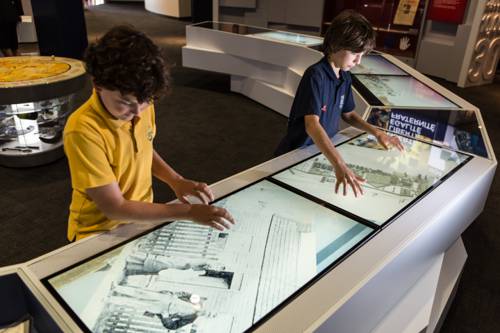
FAQ About The Role of Interactive Technologies in Modern Museum Experiences

What are interactive technologies in museums?
Interactive technologies in museums refer to digital tools and systems that engage visitors actively. These can include touchscreens, augmented reality (AR), virtual reality (VR), mobile applications, and interactive installations. The aim is to enhance the traditional museum experience and make exhibits more engaging and educational.

How does augmented reality enhance museum exhibits?
Augmented reality (AR) overlays digital information onto the real-world environment. In museums, AR can bring static exhibits to life, provide additional context, and create immersive experiences. For example, AR can animate historical scenes in a painting or offer a 3D view of an artifact from different angles.

What is the impact of virtual reality in museums?
Virtual reality (VR) creates entirely immersive environments, offering visitors experiences that would be impossible in the physical world. In museums, VR can simulate distant historical events, explore vast or microscopic environments, or allow visitors to 'walk through' different eras and artworks. This technology enriches educational experiences by delivering a deeper understanding through immersion.

How do interactive technologies make art more accessible?
Interactive technologies increase art accessibility by allowing visitors to engage with exhibits in diverse ways. Features like text-to-speech, adjustable text size on screens, and apps with detailed descriptions can aid those with visual or auditory disabilities. Furthermore, virtual tours and digital exhibits can reach global audiences unable to visit in person.

What role do touchscreen displays play in modern museums?
Touchscreen displays serve as interactive information hubs in modern museums. They can offer detailed explanations, high-resolution images, and multimedia content about exhibits. Visitors can customize their experience by selecting the information that interests them most, which personalizes their learning journey and enhances engagement and understanding.

Why are mobile apps important for museum experiences?
Mobile apps extend the museum experience beyond traditional physical visits. Apps can provide interactive maps, audio guides, and behind-the-scenes content, enhancing what visitors see in person. Additionally, they can offer interactive games, quizzes, and augmented reality features to deepen engagement and learning.

Can interactive technologies in museums support educational goals?
Yes, interactive technologies can significantly support educational goals by making learning more engaging and accessible. They can present information in varied, dynamic formats that cater to different learning styles, include interactive educational tools, and enable virtual visits to exhibitions and artifacts from anywhere around the world, thus broadening educational outreach.

How do museums use digital exhibits?
Digital exhibits in museums use high-tech displays like digital screens, virtual and augmented reality, and interactive projections to convey information. These exhibits may include multimedia elements such as video, sound, and animation to enhance storytelling and allow visitors to interactively explore complex subjects.

What are the benefits of using interactive technologies in museums?
Interactive technologies in museums offer numerous benefits, including increased visitor engagement, enhanced learning, accessibility improvements, and the ability to reach wider audiences. They make exhibits more dynamic and entertaining, allow personalized experiences, and can adapt to various visitor interests and needs effectively.

Are there any challenges with implementing interactive technologies in museums?
Implementing interactive technologies in museums presents challenges such as high costs, the need for ongoing maintenance and updates, potential technical difficulties, and ensuring inclusivity for all visitors. Additionally, there is a need for staff training and balancing digital tools with traditional exhibits to maintain the authenticity of museum experiences.

How does technology improve museum accessibility for people with disabilities?
Technology improves museum accessibility by offering features like audio descriptions, adjustable text sizes, and interactive displays that cater to individuals with visual or auditory impairments. Tools like sign language guides, sensory-friendly applications, and wheelchair-accessible digital interfaces help ensure inclusive experiences for all visitors.

Can interactive museum technologies be used for storytelling?
Yes, interactive museum technologies are excellent tools for storytelling. They enable museums to present narratives in engaging ways, such as through audiovisual presentations, interactive displays, and immersive AR/VR experiences. This helps visitors connect more deeply with the stories behind exhibits and can enhance their understanding and retention of information.

How does visitor data enhance museum experiences through technology?
Visitor data, collected through digital interactions, helps museums tailor experiences to visitors' preferences and behaviors. By analyzing data from interactive installations and apps, museums can enhance exhibit content, personalize visitor experiences, and improve future exhibits and outreach programs based on visitor feedback and interests.

How are virtual tours changing museum experiences?
Virtual tours are transforming museum experiences by making them accessible to a global audience. They allow people to explore exhibits and collections from anywhere, often offering unique views and insights unavailable during physical visits. Virtual tours can also simulate real visits, creating interactive educational opportunities for schools and individual learners.

What is the role of interactive video in museums?
Interactive video in museums allows visitors to engage with content dynamically, offering opportunities for deeper exploration of topics. These videos might include clickable elements that provide additional information, quizzes, or decision points that personalize the viewing experience and make learning more engaging and memorable.

Do interactive technologies appeal to all museum demographics?
Interactive technologies can appeal to a broad range of demographics by offering diverse engagement methods. They tend to be particularly effective with younger audiences accustomed to digital experiences. However, intuitive design and accessible features can also ensure older visitors and those less comfortable with technology still benefit from these innovations.

How do museums measure the success of interactive technology implementations?
Museums measure the success of interactive technology implementations by evaluating visitor engagement, collecting feedback, and analyzing visitor data related to the use of digital tools. Metrics like increased visit durations, positive visitor reviews, and repeat visits can also indicate successful integration.

What is multi-sensory technology in museums?
Multi-sensory technology in museums integrates various sensory inputs such as sound, touch, sight, and occasionally smell to create more immersive and memorable experiences. This type of technology can enhance engagement and understanding by catering to different learning styles and preferences, enriching the visitor experience.

Why is digital learning important in the context of modern museums?
Digital learning is essential in modern museums as it complements traditional educational methods with interactive, engaging content. It allows museums to provide more comprehensive explanations, cater to different learning preferences, and facilitate remote access to educational material. This makes learning more interactive and accessible for a wider audience.

What future developments are expected in museum interactive technologies?
Future developments in museum interactive technologies may include more advanced AR and VR applications, AI-driven personal tours, holographic displays, and smart interactive exhibits that adapt in real time to visitor interactions. These technologies will likely enhance personalization, interactive storytelling, and accessibility for diverse audiences.
